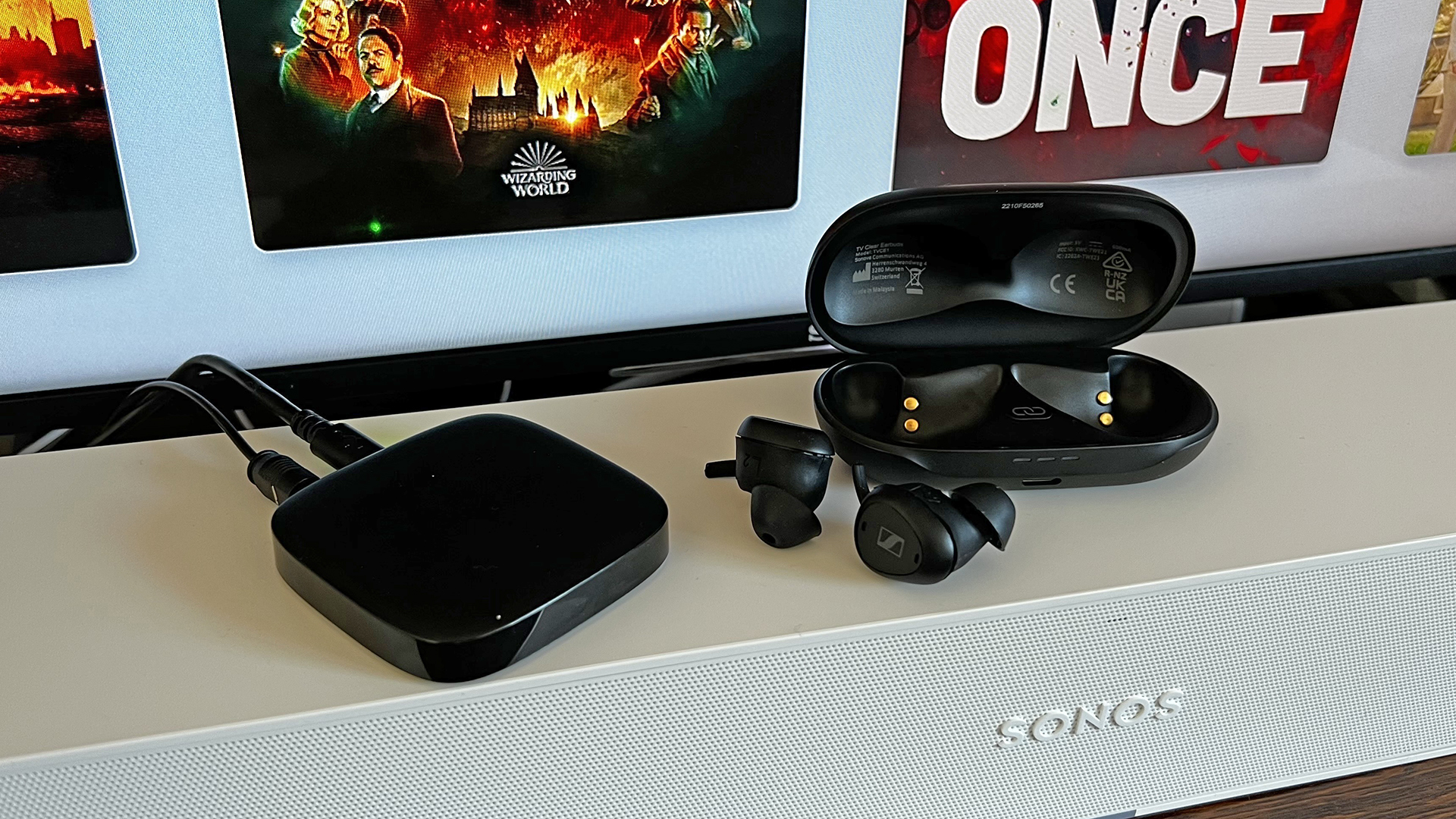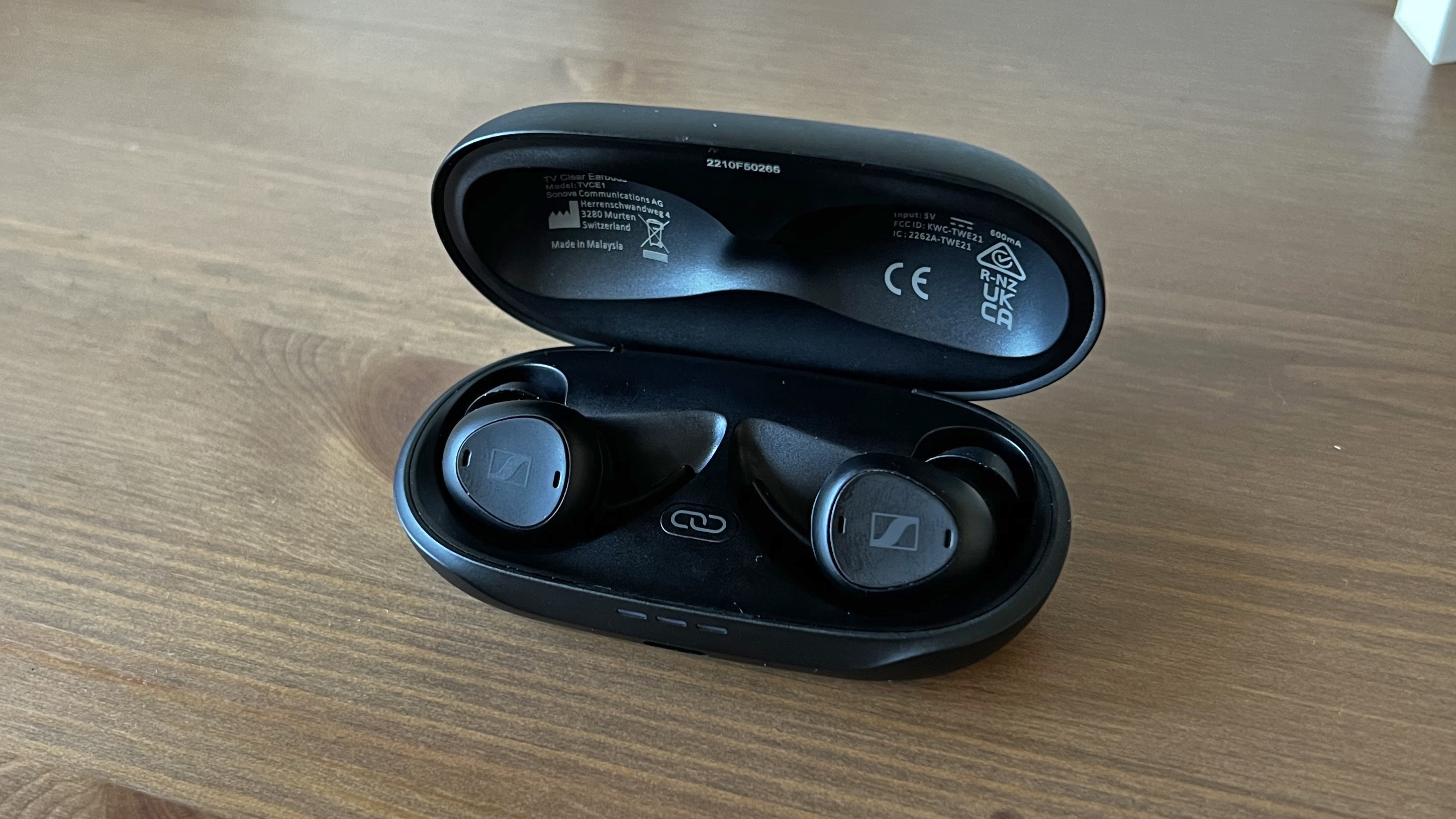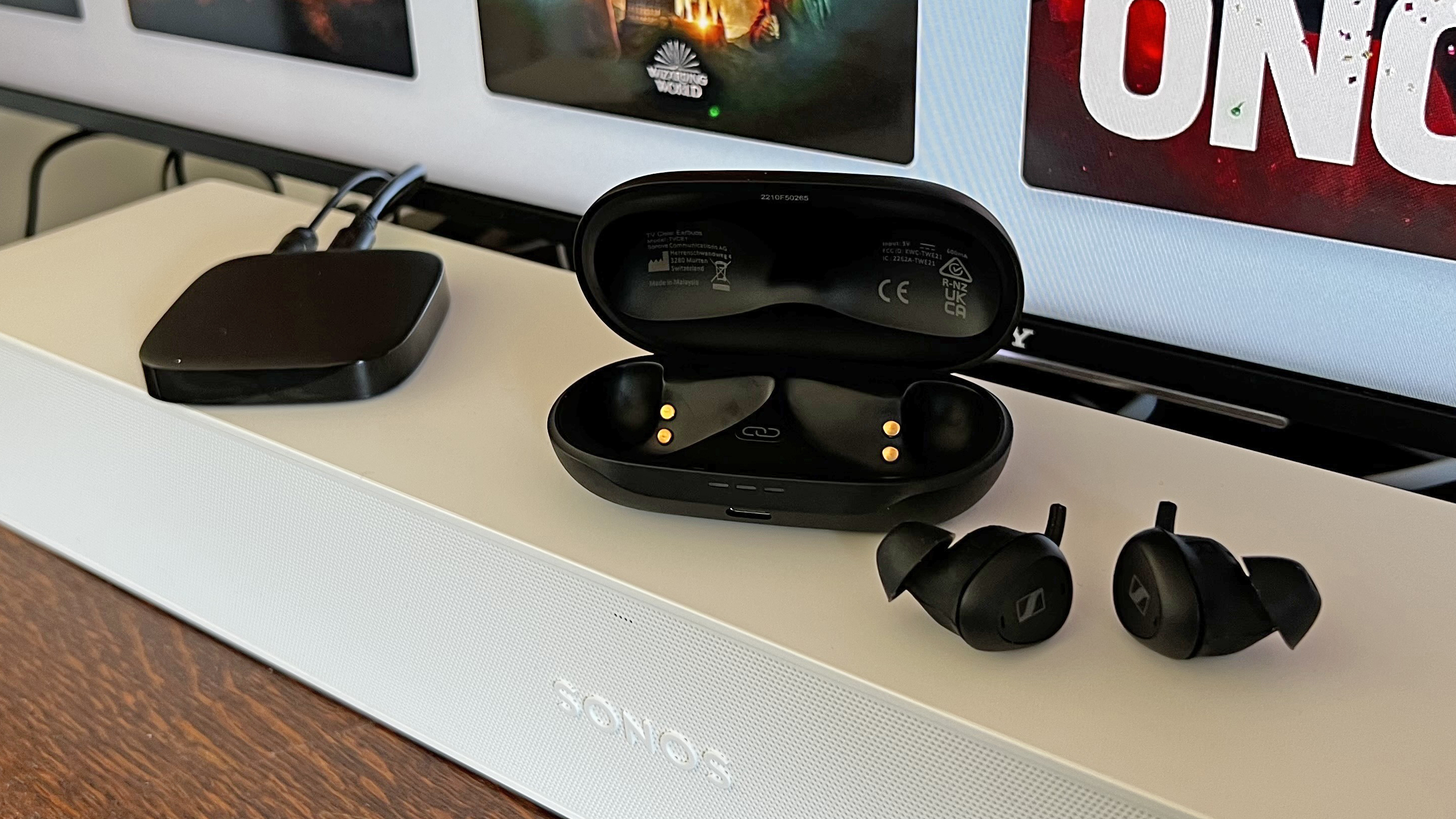I tried Sennheiser's wireless earbuds made for TVs, and they're weirder than I expected
They solve a couple of problems, but seem to create others

Sennheiser recently launched its new TV Clear true wireless earbuds. They're just like most of the best wireless earbuds out there, except that they also come with a transmitter that you connect to your TV, so you can use them with it even if it doesn't have Bluetooth.
They have a few other features geared towards TV watching too, including five different levels to amplify speech from the overall sound mix, and a highly adjustable "Ambient Sound" mode, so you can (optionally) hear what's going in the house beyond the TV, so you're not totally cut off.
I've become a convert to using headphones for watching the TV at times, thanks to the Spatial Audio you get when using Apple AirPods Pro and AirPods 3rd Gen with the Apple TV 4K. The sound is so immersive that it doesn't feel like a step backward to watch things that way if you want to watch something late without disturbing someone else in the house.
So I was looking forward to trying the Sennheiser TV Clear, because unlike my AirPods set up, they work with everything you use your TV for, not just stuff you watch through a particular streaming box.
And while that part of it works, no question, my first impression of them is that there's some weirdness here over how they perform best… especially when you factor in the eye-opening $399/£349 price. Although, Sennheiser promo codes are out there to potentially save you cash.
Seriously stereo
Setup is fairly easy if you follow the instructions. I downloaded the TV Clear app and it told me which buttons to press for pairing mode and so on. I plugged the transmitter into the optical port on my TV (you can also use a regular 3.5mm jack) and connected it to a USB port for power. Pressing a button on the case and the transmitter paired them. After that, I just put them in my ears, started a movie on the TV and it was all working.
One of the two things that really stood out to me about using them with the transmitter was immediate: they really put left and right sounds to the left and right side of you. Just using the interface on the TV, when highlighting something on the left of the screen, I could hear the sound coming from hard to the left of me, for example. That feels like a bit much.

It's the same in movies. Speech sounds balanced, as you'd expect (since it's generally centered in sound mixes), but any time something moves on-screen from left to right, you get the most exaggerated, extreme version of this, where it moves from sounding like it's fully to your left to fully on your right. Sometimes this is okay, but it's kind of odd when it's something that's clearly supposed to only move from front-left to front-right in the surround mix. Your brain wonders why something you can see on screen feels like it's fully to the side of you. It's odd, but you can get used to it.
I then tried the many different speech enhancement options, and it quickly becomes clear who this is for. The default level 1 mode just sounds normal. Level 2 promotes the mid-range in a way that largely fits with what you hear from using a speech mode on one of the best soundbars.
Then at level 3, you get to a point where vocal tones are so boosted they sound kind of artificial, and other parts of the soundscape sound very suppressed. At levels 4 and 5, the effect is so strong that it's basically unlistenable for me.
But this wasn't made for me. This was made for people who really struggle with speech, especially older people. It doesn't matter that it harms the soundscape – at least they can hear what's going on. That's the goal.
I also tested the ambient noise passthrough mode, which is generally well-done. You basically use a slider to set how much sound you want to pass through, and it comes through pretty naturally.
There's no active noise cancellation here, so some sound leaks in any way, but it really helps with awareness of when someone is trying to get your attention.
Better over Bluetooth
But then we get to the other thing that really stood out to me about using these earbuds with the TV transmitter: the sound quality wasn't great.
It's fine most of the time, though I found instantly that it's a little flat and lacking dynamic range. But it's largely clear, and I had no problem with making out speech and other details (even without the speech enhancement).
But as soon as things get busy, with lots of sounds at different volumes and a bustling soundtrack, it sounds so compressed. In the fight between Captain America and Thanos in Avengers: Endgame, you're supposed to hear resonant clangs of metal hitting metal, but here it sounds squared-off and crunchy.

It looks like the TV transmitter is to blame because when I switched to watching the exact same scene from my phone over Bluetooth, it sounded fantastic. Based on my early experience when used with my phone, these are extremely capable headphones – rich, deep, and balanced with both music and movies.
But from my TV? Disappointing. The transmitter is made with tech used in hearing aids that are supposed to be very low-latency, and that makes sense in principle – Bluetooth can have a noticeable lag, and you want what's happening on-screen and in your ears to sync.
Except I noticed a lag when using the TV Clear. It was very small, so I didn't really mind, but it raises the question: if there's going to be lag anyway, why not use Bluetooth and give me better sound quality?
(I should say, this transmitter tech enables lots of earbuds to be connected to one transmitter, and its less power-hungry than Bluetooth, so there are other advantages, but I'd rather just have reliably good audio.)
How did we end up here?
As I said in the headline, I find these earbuds to be weird. Specifically, it feels so odd to have ended up with a product that makes so much sense – connect any TV of any age to wireless earbuds – and yet to wonder how we ended up with this particular mix of poor performance in the most important area, middling specs and high price.
You could buy the fantastic Sony WF-1000XM4 earbuds (which also have ambient sound passthrough, but also include excellent noise cancellation) with Sennheiser's own Bluetooth adapter for TVs (yes, this is a thing it makes!) for less than the TV Clear set costs.
Unless you want multiple people to be able to all use matching earbuds from one transmitter, this is likely to give you far better performance, plus the Sonys are even more useful outside of the house.
You have to assume that the transmission tech is to blame for the high price of the Sennheiser buds, but when it causes poor sound quality, the cost becomes a weight around the neck of these earbuds.
Okay, you might say that the speech enhancement tech is a reason to buy them for a lot of the intended audience – and I agree, but that also harms sound quality. So the end question becomes why are these $399/£350 earbuds? The Sennheiser CX wireless earbuds cost $139/£99 and sound excellent – if you're going to compress and process the sound so heavily anyway, do you really need earbuds of any higher quality than those? When I think about the idea that these are pitched as being worth $260/£250 more than those… well, as I said. Weird.
Get daily insight, inspiration and deals in your inbox
Sign up for breaking news, reviews, opinion, top tech deals, and more.

Matt is TechRadar's Managing Editor for Entertainment, meaning he's in charge of persuading our team of writers and reviewers to watch the latest TV shows and movies on gorgeous TVs and listen to fantastic speakers and headphones. It's a tough task, as you can imagine. Matt has over a decade of experience in tech publishing, and previously ran the TV & audio coverage for our colleagues at T3.com, and before that he edited T3 magazine. During his career, he's also contributed to places as varied as Creative Bloq, PC Gamer, PetsRadar, MacLife, and Edge. TV and movie nerdism is his speciality, and he goes to the cinema three times a week. He's always happy to explain the virtues of Dolby Vision over a drink, but he might need to use props, like he's explaining the offside rule.